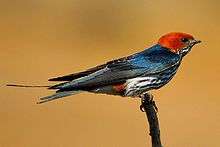Cecropis
| Cecropis | |
|---|---|
 | |
| Lesser striped swallow | |
| Scientific classification | |
| Kingdom: | Animalia |
| Phylum: | Chordata |
| Class: | Aves |
| Order: | Passeriformes |
| Family: | Hirundinidae |
| Subfamily: | Hirundininae |
| Genus: | Cecropis F. Boie, 1826 |
| species | |
|
7, See text. | |
Cecropis is a genus of large swallows found in Africa and tropical Asia. The red-rumped swallow's range also extends into southern Europe. This genus is frequently subsumed into the larger genus Hirundo.[1] The genus name Cecropis, given by Friedrich Boieis the pre-existing rail genus Crex and Ancient Greek opsis, "appearance".[2]
The swallow family consists of 74 bird species which typically hunt insects in flight. The two river martins have long been recognised as very distinctive, and are placed in a separate subfamily, Pseudochelidoninae, leaving all other swallows and martins in the Hirundininae. DNA studies suggest that there are three major groupings within the Hirundininae subfamily, broadly correlating with the type of nest built.[3] The groups are the "core martins" including burrowing species like the sand martin, the "nest-adopters", with birds like the tree swallow which utilise natural cavities, and the "mud nest builders". The Cecropsis species construct a closed mud nest and therefore belong to the latter group. It is believed that the evolutionary sequence is from species that make open cup nests (Hirundo and Ptyonoprogne), through Delichon house martins with closed nests, to Cecropis and Petrochelidon, which have retort-like closed nests with an entrance tunnel.[4]
The species are:
- Greater striped swallow Cecropis cucullata
- Lesser striped swallow Cecropis abyssinica
- Red-breasted swallow Cecropis semirufa
- Mosque swallow Cecropis senegalensis
- Red-rumped swallow Cecropis daurica
- Sri Lanka swallow Cecropis hyperythra
- Striated swallow Cecropis striolata
- Rufous-bellied swallow Cecropis badia
References
- ↑ Angela K. Turner; Chris Rose (November 1989). Swallows & Martins: An Identification Guide and Handbook. Houghton Mifflin. ISBN 978-0-395-51174-9. Retrieved 16 February 2012.
- ↑ Jobling, James A (2010). The Helm Dictionary of Scientific Bird Names. London: Christopher Helm. p. 121. ISBN 978-1-4081-2501-4.
- ↑ Sheldon, Frederick H.; Whittingham, Linda A.; Moyle, Robert G.; Slikas, Beth; Winkler, David W. (April 2005). "Phylogeny of swallows (Aves: Hirundinidae) estimated from nuclear and mitochondrial DNA". Molecular phylogenetics and evolution. 35 (1): 254–270. doi:10.1016/j.ympev.2004.11.008. PMID 15737595.
- ↑ Winkler, David W.; Sheldon, Frederick H. (June 1993). "Evolution of nest construction in swallows (Hirundinidae): a molecular phylogenetic perspective" (PDF). Proceedings of the National Academy of Sciences USA. 90 (12): 5705–5707. doi:10.1073/pnas.90.12.5705. PMC 46790
 . PMID 8516319.
. PMID 8516319.